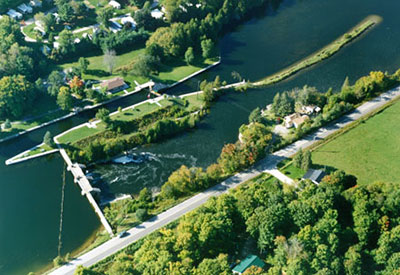Lost in a Nova Scotia Fog

Herbert L. Stone
You have all run in a fog at some time or other in your yachting careers! It is a safe bet that none of you like to do it – in spite of the satisfaction that comes when you pick up your buoy, or begin just where it should be, after you have run your distance down – and most of you agree with the men who follow the sea for a living rather than for pleasure that they would sooner face gale of wind than a fog of any duration. When you get them both together, however, you are indeed in hard straights, especially when the land is close aboard.
I got mixed up with this combination once, with the fog lasting for three days on end. Black, blinding, choking Nova Scotia fog it was, with a trong, treacherous, swirling Fundy tide under us just to keep us from going to sleep on our jobs. The combination nearly got us at that, and when the sense-deadening mist finally blew away and showed us the land and the outlying ledges off our starboard beam our minds cleared up slowly, just as they did when we got our senses back after whirling round and round and round, as we used to do when boys.
It happened in this way, and if you are interested in dead reckoning navigation you will like to hear about it, maybe. We had been lying in Digby, Nova Scotia, for three days waiting for the fog to blow away, so that we could start back for the States on our homeward cruise, Annapolis basin being our “Farthest North” that year. Our yacht was auxiliary yawl Piute. Forty-three feet on the water she was, 60 feet over all, designed by that master-hand Cary Smith, and for power she had a 20-horsepower, two-cylinder motor tucked away in the lazarette that would knock her along something over six knots or seven statue miles. We had jogged along leisurely on the way up, stopping at most of the Maine ports, and were in a hurry to get back, so that we were willing to make some long jumps, if necessary.
Finally, on the fourth morning the glass, which had been stationary, went down three-tenths, and, looking for a westerly, I decided to make a start, though the fog was still as thick as ever, calculating it would blow away before we made the other side of the Bay. So we hove short and broke out, and, turning the engine over, we got a kick the first try and very carefully felt our way through Digby Gut, with a fair tide under us – – and maybe the tide doesn’t ebb through that narrow passage! Outside in the Bay of Fundy it was thicker yet, if that was possible, but we laid off our course, put her on it, and taking a departure from Prim Point Light, we let her go W. by N. magnetic, intending to make Grand Harbor, Grand Manan, on the New Brunswick side, some 50 miles away. The breeze hadn’t struck in yet, so we let the engine do the work and intended to run our distance down in true powerboat fashion, allowing for the S.W. ebb and keeping a man on the patent bellows foghorn until he got blisters on his hands. We didn’t hear anything on our way across, however – in fact there isn’t much to hear in those waters, anyway, expect on occasional St. John bound steamer or a stray fisherman.
About noon, when we were half way across the Bay, a light sou’-west breeze came up, and as we could just lay our course with it we set lower sails and socked it to her, with engine going as well. Now, in the Bay of Fundy a sou’wester instead of bringing clear drives in fog, and then more fog, from the fog factory off Cape Sable, until there seems never an end to it; so the drop in the glass we had counted on probably indicated a sou’wester instead of a nor’wester, though the wind might still go on through to west, we hoped.
As the afternoon advanced and we approach Grand Manan with still no signs of its clearing we began to get a little uneasy, and when the patent log read 40 miles and we had nearly run our distance down we shut the engine off and laid her to on the increasing sou’wester with staysail hauled aweather while we debated our next move. If you will take a look at a chart of Grand Manan you will see why. To the south and southeast of the island stretches a mass of ledges, small islands and reefs, partly under water and partly awash, through which the tide surges at three to four knots an hour, and very poorly marked. It was foolhardy to attempt to make Grand Harbor after a run across the bay cross-tide and a very doubtful landfall! There were two courses open to us; either to run to the north of Grand Manan and try to make in by the north end of Campobello, or let her go S.by E. out into the Bay of Fundy and work down between the Nova Scotia shore and Grand Manan into the Atlantic and then head for Rockland, Me., some 125 miles away. 
The latter seemed the wiser course, as the coast north of Manan was rocky and bold, with the Wolves sticking their fangs out in a string of iron-bound islands to leeward that might catch us, while the water off Campobello was from 40 to 60 fathoms deep right up to the shore, so that the lead would be of little use. We were in a bad mess either way, for it was coming on to blow and night would soon be upon us. So we cast about on the starboard tack off White Head Island (we were pretty sure of our position then, though the dense fog shut out everything we made no landfall) and let her go out into the Bay, which is here some 25 miles wide, close hauled with the engine shut off, as we could not force her too much.
At six o’clock it was breezing up fast and we turned two reefs in the mainsail before going to supper, which was not eaten in much comfort, for the sea had made up fast. You want bear in mind that the mouth of the Bay of Fundy is the worst place in the world for seas. The flood stream runs about three knots and the ebb up to four and one-half knots, so with a nor’easter or sou’easter working against them it is no place for a minister’s son.
After supper it was still piping up, with wave on wave of suffocating black fog rolling over us, until when the night settled down it was so black you couldn’t make the sails, spars, or even the boats on the davits. As we must not get too near the Nova Scotia Coast and the wicked North West Ledge, and as she couldn’t carry her sail longer, there was nothing to but heave her to; so we got the mainsail off her, stowed the jib and, finding the reef tackle in the mizzen, somehow, we turned a reef in it, and with the staysail boom amidships we let her come up within four and one-half points and jogged her along easy. She took the seas better now that her way was stopped, but we were uncertain about her drift to leeward. She was centerboarder and didn’t hold on like a keel boat, though the board was about half down. According to the tide table the tide ran flood at two and one-half knots until nine p.m.,and then ebb until three a.m. at a three knot rate, so that ebb ought to set us W.S.W at about one and one-half knots per hour, allowing one and one-half knots for our leeway, hove to, though we were forging ahead a little through the water all the time.
So far so good! We wore ship every two hours so as to keep her about in the middle of the Bay between Grand Manan and the Nova Scotia shore. After the tide turned and began to ebb strong, the sea got up alarmingly. Instead of the long regular seas of flood tide they became high and steep, with deep hollows between the waves, and no room for a 60-foot boat to rise to them. They tumbled aboard out of the blackness over the weather bow or over the stern, and every now and then one would break at the main shrouds and rip aft along the rail, emptying tons of solid water on deck. And all the time the wind was piping through the rigging and swirling black fog nearly choked us on deck, while the mournful blast of our foghorn was whirled away to leeward on the sou’wester. It couldn’t have been a couple of hundred feet to windward. I logged our estimated drift each hour and kept account of each time we tacked, but it was all guesswork as our log had been hauled in when we hove to, the engine was shut off, and there was over 100 fathoms of water under us, so that a hand lead was of no use.
Though the watch off duty went below there was no sleep for any of us, for they could not only not stay in their bunks the way she was jumping, but their minds were too intent on our situation to permit of repose. About three in the morning I heard faintly from out the blackness to windward the sound of breaking water. I thought at first it was only a bad tide rip, of which the charts shows many in these waters, but it was enough to set me all on edge. The sound grew rapidly, however, showing that the tide was setting us windward fast in spite of our leeway, and then suddenly and unmistakably I heard the swash of seas breaking on rocks, though the wet, swirling mist driven by half a gale blinded us to its location and everything outside was as black as the interior of a coal mine. There was only one thing to do and, yelling to George, my watchmate, to let go the mizzen sheet I put the wheel hard up and let her drive off to leeward under the jib, not knowing what danger might lie there, but feeling that anything was better than being set on the hidden ledge to windward. After driving off for 15 minutes I let her come around on starboard tack and tried to carry enough sail on her to get us back from where we had come originally-though heaven only knew where that was.
After working out S.S.E for half an hour we heard a low moan, as from a sick cow off to leeward, the very first sound outside of what we had made ourselves that we had picked up since we left Prim Point the previous morning. Diving below for a look at the chart and light book I ran hastily down the lights on northerly side of the Bay (I knew we couldn’t be on the Nova Scotia side) to try to locate it. The only aid to navigation near where we should have been was the gas buoy on Old Proprietor Ledge, and it had no fog whistle. More and more distinctly came the sound and I timed the intervals between, but that didn’t help, as the light book didn’t give them. The next lighthouse on the north side was on Gannet Rock and my hair actually lifted on my head as I realized it must be it we were hearing, and that we were in on the deadly Murr Ledges to the west of the rock, through which the Fundy tide swirled and eddied in all directions with dangerous rips. But how did we get down that far and how could we have worked in past the light and not heard it, for Gannet Rock was eight miles to the west of where we supposed we were?
There was no time to ponder on these questions then, however; all of our faculties were bent on working out clear of the rock into deep water- and God help us if we were wrong in our deductions and clear water didn’t lie in the direction we supposed. As it was to leeward we could not have heard the fog syren far, and we must have been very close to Gannet Rock when we had the sound bearing N.E. and hauled to S. heading, as we prayed, for deep water. As the tide was just about on the turn we could not heave to again as soon as we lost the sound of the siren for fear of drifting back on it, for our leeway and the set of the tide of the side were now both in the same direction and we would have been set back on the rock at the rate of some five knots an hour. So we had to carry sail and drive her into it until well clear of all danger. The way the pour old Piute was punished the next three hours made us wonder if she would stand the pounding.
Luckily the sea became less wicked after the tide turned more and more long and regular, though cresting badly, so we made headway under staysail and mizzen. To help out, as we couldn’t carry as much sail as we needed, we started the engine. It was some trick to get it turned over in that sea, but priming her first and using the bar as best we could we finally got a kick and, making sure we were using the gasoline from the windward tank (the leeward one was so low we feared it would not feed carburetor), we climbed back on deck and let it take care of itself. And it did! I have long known what an engine meant to a sailboat in calm weather, but I never fully realized before its value in a tight place in a breeze of wind. If it hadn’t been for the powerful coffee-mill below, I doubt if we could have worked clear of those Grand Manan ledges.
Daylight came at last, but it was only a change from jet black mist to an impenetrable gray one, with just enough light filtering through to let us see the bow, and no more. The wind abated, however, and dropped to a fresh breeze, in which we could carry sail and we set a double-reefed mainsail after breakfast.
For three hours we stood out to the southward, figuring that we had done 12 miles and had been set six miles up the Bay by the flood, so that we were about half way between Old Proprietor and Brier Island. Then we came about and headed west for two hours; took another hitch to S. by E., so as to be well clear of Grand Manan Bank, another bad spot twenty miles southwest of the island, and, the tide starting to ebb again, we breathed easier as we figured that we were out in the Atlantic at last, with plenty of sea room, and could shape a course to the westward in safety until we got down to the neighbourhood of Mount Desert Rock 70 miles away, a lonely obstacle some 18 or 20 miles off shore. The fog would doubtless blow away before we got there.
Being now reasonably sure of our position, we tried to account for getting in on the Murr ledges and came to the conclusion that we were either off in on our departure from White Head Island at 4:10 p.m. (which might very well have been), or that our leeway wasn’t as much as we figured and the ebb tide ran stronger as we got in near the ledges (the chart gave it four and one-half knots there) and had set us to the westward at some three knots an hour instead of the Bay. This would have put us about where we found ourselves when we heard the fog syren.
The fog was still as thick as ever when we drew in on the Maine coast, and though the wind went to south so that we could lay a course to take us well clear to the land, we had no point of departure, and with our premise wrong the answer was bound to be uncertain. We pretty nearly wore the glass out watching for some movement in it, but it remained stationary until the desire to hammer it down was almost irresistible.
Another night came and found us flopping around in a slop of sea and no wind in the vicinity of Isle-au-Haut. We had not picked up the fog signal on Mount Desert Rock, and were still anxious and uncertain as to our position, while the water was too deep to give us any help from the lead. We tried a cast several times, but we had only 40 fathoms of line on a 14-pound hand lead and could get no bottom.
I had gone below at midnight to try to get a little sleep, the first in 40 hours, and had taken off my dripping, fog-soaked clothes and turned into fog-soaked blankets. Dropping off to dream of fog syrens, bell buoys and the like I was awakened at daylight to be told that the glass was going down and was now 29.75, the best news that could have been brought, barring the announcement of a clear day, and I rolled over and slept again till breakfast. We had now been 48 hours, at no time of which could we see beyond the end our bowsprit, with a head wind most of the time and no check on our position, barring the doubtful one of Gannet Rock; but the end was not yet.
It came early in the afternoon, however, when the fog blackened up so that we had to light the binnacle lamp to see the compass, and warned us to shorten sail for a squall. We stowed the mainsail in feverish haste now knowing what was coming, or how near it was, and then stood around awesomely and expectantly for it to break. First came a few big drops of rain, then sharp, cold wind from the southwest, then a deluge followed by a sudden shift of wind to the northwest, while we tore through the water like a U-boat half submerged and headed up as high as we could. The first blast soon passed and the wind settled to northwest, the fog gradually thinned, the position of the sun (though not the sun itself) could be made out and half an hour later we saw the blue sky overhead, the blue, white flecked surface of sea to windward and, when the last vestige of detested mist had blown away, there lay a Maine island, rock bound and fir clad, not two miles off our starboard beam. It was our first landfall-but was it?
Standing in for the land we coasted along it as the afternoon waned, “hooking up” the engine in our eagerness to get in somewhere, and presently made out the Camden hills to the north of us. Then we knew that we had come straight and hadn’t overrun our distance, and that all our groping hadn’t been in vain. We were on our course and close to our aimed-at destination.
That evening, just as the sun was going down and after a hard little thrash to windward, we slid in behind Rockland breakwater, let go our hook and turned in without waiting for supper for the first real sleep we had since leaving Digby.
Originally published in The Best From Yachting: A Sixtieth Anniversary Selection
November 1967





























